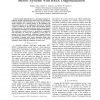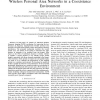GLOBECOM
2007
IEEE
14 years 7 months ago
2007
IEEE
— The optimum resource allocation is an important method to improve the error performance and energy efficiency of wireless relay networks. In this paper, we consider the resour...
GLOBECOM
2007
IEEE
14 years 7 months ago
2007
IEEE
— Adaptive transceivers play an important role in wireless communications and the design of MIMO systems. Therefore models that enable simulation of dynamic and time varying chan...
GLOBECOM
2007
IEEE
14 years 7 months ago
2007
IEEE
— A low complexity soft-input soft-output (SISO) block decision feedback equalization (BDFE) algorithm is presented for Turbo equalization. Based on minimum mean square error (MM...
GLOBECOM
2007
IEEE
14 years 7 months ago
2007
IEEE
—This paper simulates a typical indoor MIMO-UWB OFDM system using computational electromagnetics. The goal is to create a simulation using a real world environment and taking int...
GLOBECOM
2007
IEEE
14 years 7 months ago
2007
IEEE
—The adaptation of structured P2P networks, i.e. Distributed Hash Tables (DHTs), to wireless ad-hoc networks has been investigated in recent years. Existing work assume all peers...
GLOBECOM
2007
IEEE
14 years 7 months ago
2007
IEEE
— Differential Unitary Space-Time Block codes (STBCs) offer a means to communicate on the Multiple Input Multiple Output (MIMO) channel without the need for channel knowledge at ...
GLOBECOM
2007
IEEE
14 years 7 months ago
2007
IEEE
— With the advent of MPLS, the restoration times of communications is decreased down to 50 ms by the use of preconfigured backup LSPs. To ensure there are enough resources after ...
GLOBECOM
2007
IEEE
14 years 7 months ago
2007
IEEE
GLOBECOM
2007
IEEE
14 years 7 months ago
2007
IEEE
Abstract— The use of multi-user detection (MUD) in a cooperative CDMA network is investigated for the uplink in synchronous CDMA systems. Suppose that, at any instant in time, pa...
GLOBECOM
2007
IEEE
2007
IEEE
Enhanced Adaptive Frequency Hopping for Wireless Personal Area Networks in a Coexistence Environment
14 years 7 months ago
— In this paper, we present an enhanced adaptive frequency hopping (EAFH) mechanism for improving the performance of frequency hopping-based wireless personal area networks (WPAN...


